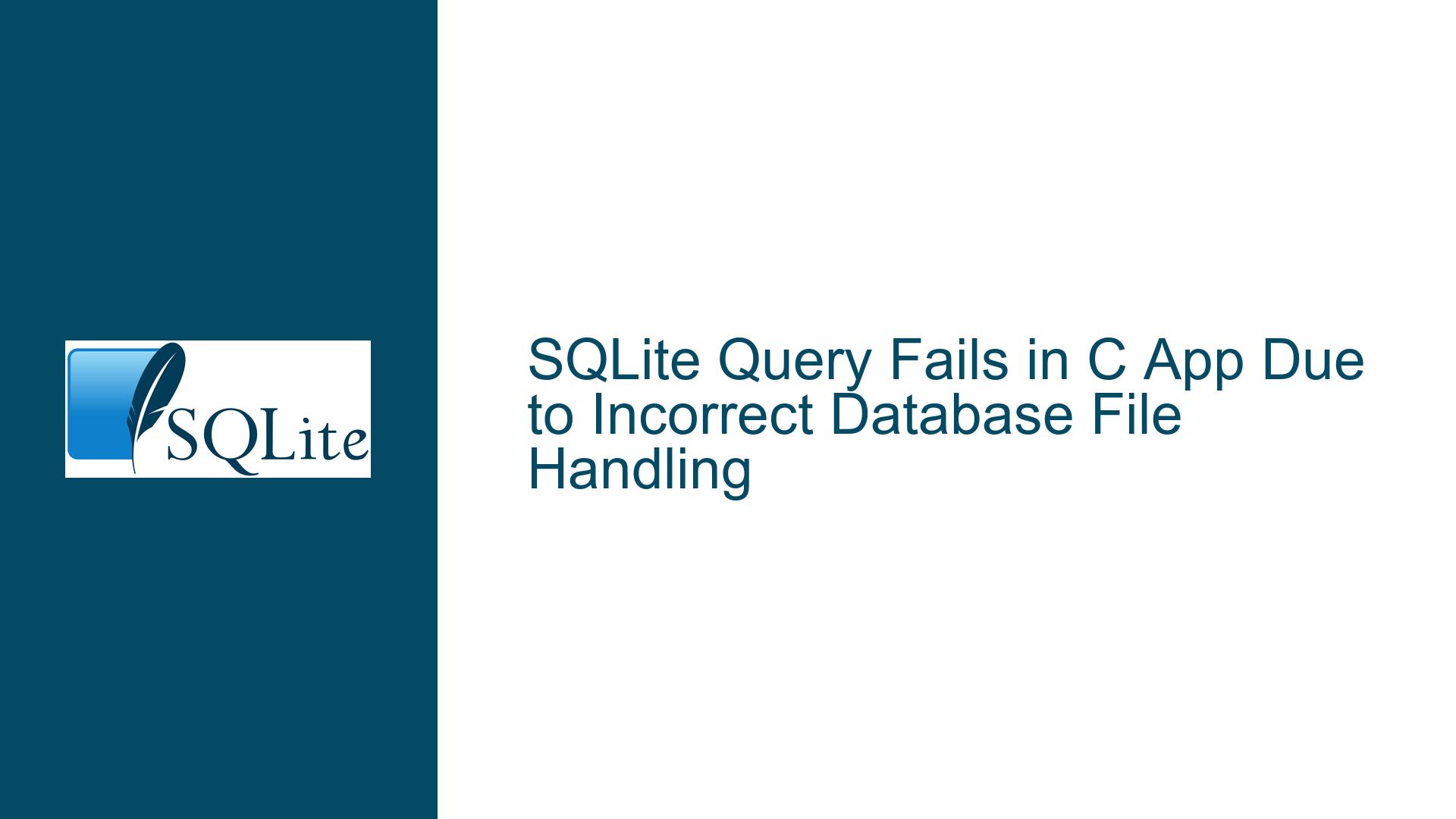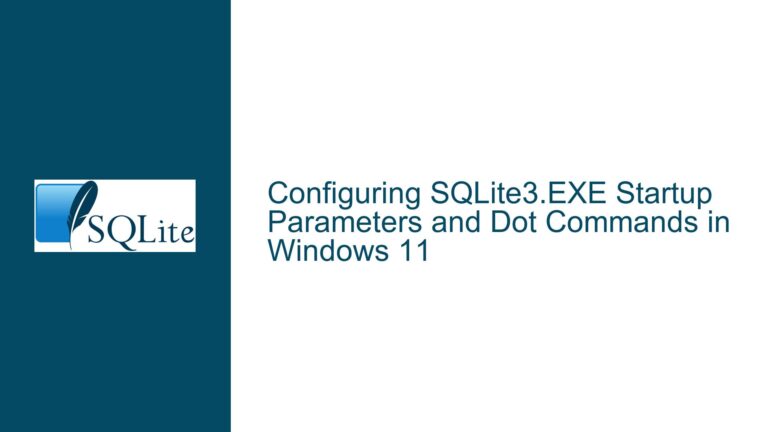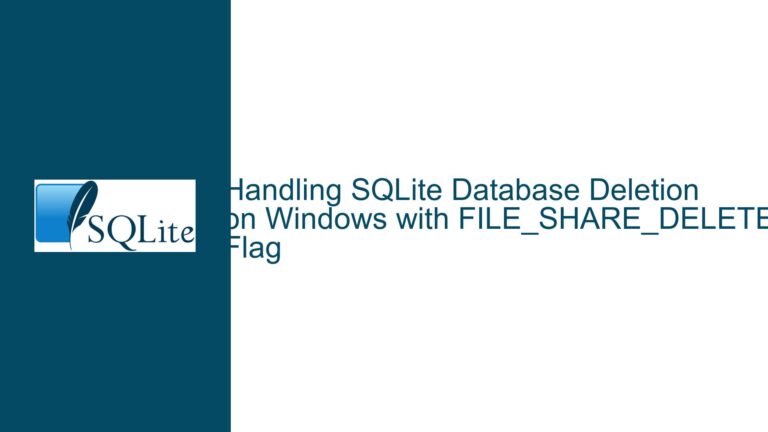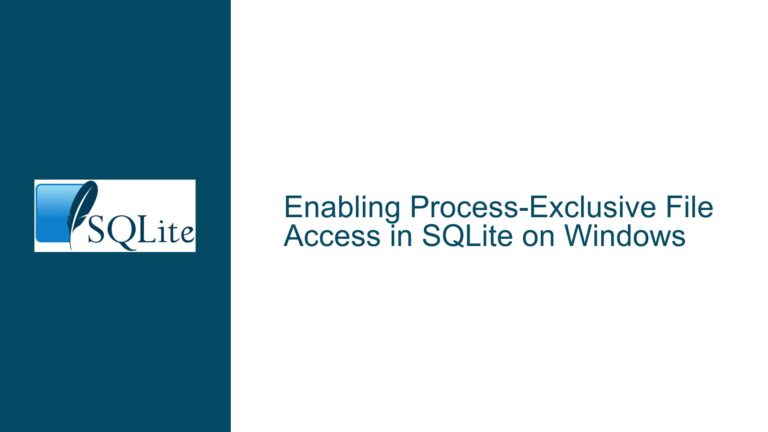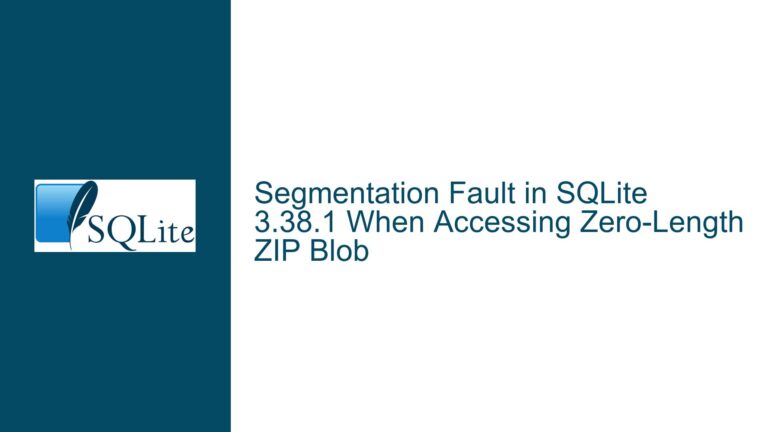SQLite Query Fails in C App Due to Incorrect Database File Handling
Database Connection Discrepancy: Mismatched Filenames and Open Modes
Issue Overview: Table Not Found When Executing Query in Custom C Application
The core issue arises when a SQLite query that successfully executes in the sqlite3 command-line interface fails in a custom C application with the error "no such table: TermNoList". This discrepancy occurs despite identical query syntax and apparent connectivity to the database. The root cause is a mismatch between the database file handling in the command-line tool and the C application, combined with SQLite’s default file-opening behavior.
Key Observations:
- Command-Line Success:
Thesqlite3CLI opensNewIXSystemJOHNU_HOME.dband successfully queries theTermNoListtable. - C Application Failure:
The application attempts to openNewIXSystemJOHNU_HOME(without the.dbextension) usingsqlite3_open(), resulting in a new empty database file being created implicitly. This explains the "no such table" error, as the empty database lacks the expected schema. - File System Artifacts:
Directory listings reveal two distinct files:NewIXSystemJOHNU_HOME.db(valid database with schema)NewIXSystemJOHNU_HOME(newly created empty file)
Critical Factors:
- File Extension Ambiguity:
SQLite does not enforce file extensions, but omitting them increases the risk of naming collisions. The CLI and C application opened different files due to inconsistent naming. - Implicit Database Creation:
Thesqlite3_open()API creates a new database file if the specified filename does not exist, unless explicitly prevented via flags. - Working Directory Mismatch:
Applications may execute from different working directories than expected, causing file path resolution errors.
Possible Causes: Database File Handling and API Misuse
1. Incorrect Filename or Path in C Application
- Symptom: Application opens
NewIXSystemJOHNU_HOMEinstead ofNewIXSystemJOHNU_HOME.db. - Mechanism:
Thesqlite3_open("NewIXSystemJOHNU_HOME", &pDBAiPhone)call creates a new database if the file doesn’t exist. Unlike the CLI, which auto-appends.dbin some configurations, the C API uses the exact provided filename.
2. Unintended Database Creation via Default Flags
- Default Behavior of
sqlite3_open():
Equivalent tosqlite3_open_v2()with flagsSQLITE_OPEN_READWRITE | SQLITE_OPEN_CREATE. This creates a new database if the file doesn’t exist, masking errors when developers assume the file already exists.
3. Schema Deployment Failure
- Missing Schema Initialization:
If the application logic assumes an existing database but doesn’t handle schema creation, newly created databases will lack tables. This often occurs in configurations where database setup is delegated to external scripts.
4. Environment Differences Between CLI and Application
- Working Directory:
The application may execute from a different directory than the CLI, causing path resolution discrepancies. - File Permissions:
Read/write permissions on the target file or directory might differ between the CLI and application runtime environments.
Troubleshooting Steps, Solutions & Fixes: Resolving File Handling and API Issues
Step 1: Validate Database Filename and Path
Action: Verify the exact filename and path used in both CLI and application.
Implementation:
Inspect File System:
ls -l NewIXSystemJOHNU_HOME*Confirm that
NewIXSystemJOHNU_HOME.dbexists andNewIXSystemJOHNU_HOMEis either absent or intentionally created.Absolute Paths in Code:
Replace relative paths with absolute paths to eliminate working directory ambiguities:sqlite3_open("/full/path/to/NewIXSystemJOHNU_HOME.db", &pDBAiPhone);Add Debug Logging:
Print the resolved database path before opening:printf("Opening database at: %s\n", "/path/to/database.db");
Step 2: Enforce Strict File Existence Checks
Problem: sqlite3_open() silently creates new files, leading to false assumptions about database state.
Solution: Use sqlite3_open_v2() with explicit flags to control file creation.
Implementation:
int flags = SQLITE_OPEN_READWRITE; // Open existing database only
int rc = sqlite3_open_v2("NewIXSystemJOHNU_HOME.db", &pDBAiPhone, flags, NULL);
if (rc == SQLITE_CANTOPEN) {
fprintf(stderr, "Database does not exist or cannot be opened.\n");
}
Flag Combinations:
SQLITE_OPEN_READONLY: Open existing DB as read-only.SQLITE_OPEN_READWRITE: Open existing DB for read/write.SQLITE_OPEN_READWRITE | SQLITE_OPEN_CREATE: Create DB if missing (default).
Step 3: Verify Schema Presence After Opening
Action: After successfully opening the database, verify that expected tables exist.
Implementation:
const char *check_sql = "SELECT COUNT(*) FROM sqlite_master WHERE type='table' AND name='TermNoList';";
sqlite3_exec(pDBAiPhone, check_sql, ifcb_Read, 0, &err_msg);
Response Handling:
- If the count is
0, the table is missing, indicating either an incorrect database file or failed schema deployment.
Step 4: Use File System Checks to Prevent Accidental Creation
Problem: Applications may inadvertently create empty databases due to typos or path errors.
Solution: Check for file existence before opening.
Implementation in C:
#include <unistd.h>
if (access("NewIXSystemJOHNU_HOME.db", F_OK) != 0) {
fprintf(stderr, "Database file does not exist.\n");
exit(EXIT_FAILURE);
}
Caution:
- Race conditions may occur if the file is deleted after the check but before opening.
- Prefer using
SQLITE_OPEN_READWRITEwithoutSQLITE_OPEN_CREATEto avoid redundant checks.
Step 5: Centralize Database Configuration
Problem: Hardcoded filenames scatter configuration across the codebase.
Solution: Use environment variables or configuration files for database paths.
Implementation:
const char *db_path = getenv("APP_DATABASE_PATH");
if (!db_path) db_path = "default.db";
sqlite3_open_v2(db_path, &pDBAiPhone, SQLITE_OPEN_READWRITE, NULL);
Step 6: Enhance Error Handling and Diagnostics
Problem: Generic error messages like "SQL error" provide insufficient debugging context.
Improvements:
Log Detailed Errors:
if (iRet != SQLITE_OK) { fprintf(stderr, "SQL error (%d): %s\n", iRet, err_msg); fprintf(stderr, "Failed query: %s\n", sql); }Enable Extended Error Codes:
int extended_rc = sqlite3_extended_errcode(pDBAiPhone); printf("Extended error code: %d\n", extended_rc);Check Database Connection State:
if (sqlite3_db_readonly(pDBAiPhone, "main")) { fprintf(stderr, "Database opened in read-only mode.\n"); }
Step 7: Cross-Validate CLI and Application Environments
Action: Ensure the application environment matches the CLI’s environment.
Checks:
Working Directory:
char cwd[1024]; getcwd(cwd, sizeof(cwd)); printf("Current working directory: %s\n", cwd);File Permissions:
ls -l NewIXSystemJOHNU_HOME.db # Check for read/write permissions for the application's userFile Contents:
Use the CLI to inspect the database opened by the application:sqlite3 NewIXSystemJOHNU_HOME.db "pragma schema_version; select * from sqlite_master;"
Step 8: Adopt Defensive Schema Initialization
Problem: Applications may assume pre-existing schemas without handling initialization.
Solution: Embed schema creation logic in the application.
Implementation:
const char *create_sql =
"CREATE TABLE IF NOT EXISTS TermNoList ("
" TERMNO TEXT PRIMARY KEY,"
" TABLENAME TEXT"
");";
sqlite3_exec(pDBAiPhone, create_sql, NULL, 0, &err_msg);
Considerations:
- Use
IF NOT EXISTSto avoid errors during repeated executions. - Version schema changes using
user_versionpragma.
Step 9: Utilize SQLite URI Filenames for Advanced Options
Benefit: URI-based filenames enable additional parameters, such as immutable mode or cache settings.
Implementation:
int flags = SQLITE_OPEN_READWRITE | SQLITE_OPEN_URI;
sqlite3_open_v2("file:NewIXSystemJOHNU_HOME.db?mode=rw", &pDBAiPhone, flags, NULL);
Parameters:
mode=ro: Read-only mode.cache=private: Use a private cache.
Step 10: Profile and Audit Database Connections
Action: Use SQLite’s diagnostic functions to trace database operations.
Tools:
SQLite Logging:
sqlite3_config(SQLITE_CONFIG_LOG, log_callback, NULL);Implement
log_callbackto capture internal logs.Tracing SQL Execution:
sqlite3_trace_v2(pDBAiPhone, SQLITE_TRACE_STMT, trace_callback, NULL);Memory Usage Analysis:
sqlite3_db_status(pDBAiPhone, SQLITE_DBSTATUS_CACHE_USED, &curr, &highw, 0);
Final Recommendations:
- Always use
sqlite3_open_v2()with explicit flags. - Validate database paths using both code checks and filesystem inspection.
- Embed schema initialization logic unless deployment scripts are guaranteed.
- Log detailed diagnostics, including resolved paths and SQLite extended error codes.
By methodically addressing filename discrepancies, API flag usage, and environment validation, developers can eliminate "no such table" errors caused by unintended database file creation or path resolution issues.
